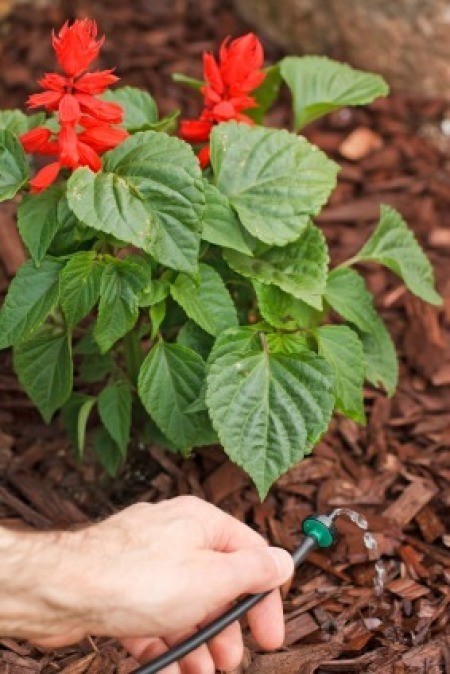Watering the garden is a simple, but critical, task. Give them too much and plants will drown, too little and they will dehydrate. Some ways of watering are smarter than others, and once you get the hang of it, you will naturally develop a sense of how much water your plants really need.
The first step in smart watering is getting to know your soil and its ability to hold moisture. Is it predominantly clay or sandy loam? Is it unusually rich in organic matter? Clay soils have a greater capacity to hold water than sandy loams, and therefore take longer to dry out. Unfortunately, because the soil particles are tightly held together and difficult to permeate, they are also more prone to run-off. Sandy loam dries out quickly, while soil that is rich in organic matter stays evenly moist most of the time.
Limited water supplies and periodic droughts have caused many municipalities to place restrictions on watering. You can help conserve water in your area by selecting plants that are well adapted to local conditions and by using smart watering and cultivation techniques.
Soaker hoses, drip irrigation pipes, hand watering and even overhead sprinklers can all be efficient ways to deliver water when they are properly used.
Soaker Hoses: Soaker hoses are lightweight and easy to move from one part of the garden to another. Water seeps through tiny holes in the walls of the hose and is delivered to plants at a slow, even rate. Soaker hoses operate at low water pressure and are ideal for irrigating rows of plants in the vegetable garden, or irrigating trees or shrubs that need frequent watering. The hoses can be placed between the soil and mulch and left there permanently, or laid on the ground next to plants.
Drip Irrigation: Drip irrigation systems are made of a network of plastic pipes fitted with special devices called emitters, which discharge water a drop at a time. Like soaker hoses, a drip irrigation system works at low water pressure and is easily customizable to individual gardens. These systems are designed to be semi-permanent and work well for established plantings like fruit trees, shrubs and groundcovers.
Hand Watering: Sometimes watering plants by hand is the easiest and most practical option. In order to do it efficiently, you'll want to invest in an adjustable nozzle that emits water in several different patterns'a gentle shower, a light mist, and a full stream. Adjustable nozzles are equipped with a trigger shut-off valve, which also saves you from making trips back and forth from the faucet.
Sprinklers: When used improperly, overhead and impulse sprinklers can be big water wasters'inadvertently watering surfaces like sidewalks and driveways in addition to your plants. When you use sprinklers, you can increase their efficiency by positioning them to cover specific areas. They are best for watering large expanses of lawn or groundcovers.

About The Author: Ellen Brown is an environmental writer and photographer and the owner of Sustainable Media, an environmental media company that specializes in helping businesses and organizations promote eco-friendly products and services.
Add your voice! Click below to comment. ThriftyFun is powered by your wisdom!
I collect cold water from the faucet that usually goes down the drain while I'm waiting for it to get hot. Also when I wash dishes I use that water for watering plants after dishes are done.
Living in Arkansas, we have high humidity here in the heat of summer. My daughter and I both run dehumidifiers in our kitchen.
Add your voice! Click below to comment. ThriftyFun is powered by your wisdom!